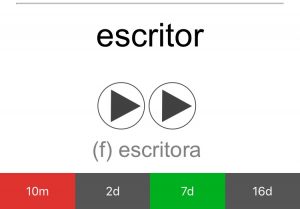My daily routine at the moment pretty much evolves around Anki and the flash cards I am creating.
Broadly speaking my daily effort follows these three main activities:
- Reviewing words learnt previously
Learning new words
Preparing at least 20 new words for tomorrow’s learning
Activities 1 and 2 are generally done together. This is because Anki will automatically present old cards for review AND show new cards for me to learn.
You can control the rate at which Anki presents these cards too you.
What I have had to do is tweak this setting otherwise I wouldn’t be at the rate of learning 20 new ones a day.
My tweaking (not twerking!) has paid off because I am now at the stage of learning new words today that I entered for the first time in Anki yesterday.
It has taken a bit of time to get to that stage.
You don’t have to align it exactly like that. The important thing is that once you are into a rhythm of REVIEW + LEARN, you have enough new cards in “the hopper” .
So today I spent a little under 90 minutes reviewing previously seen cards and learning new ones.
In amongst all that there were words at various stages of being cemented into my memory.
Some were words that I learnt weeks ago and have become old friends.
Others were ones only encountered in the past few days and were like strangers to me… and of course all of the variants in between.
Here’s How Anki Works
When using Anki after answering a card question you can rate your answer with one of up to four buttons.
Usually there is a red and a green button. Green for good and all’s happy and red for not so good.
I developed the routine where if I got any part of it wrong, pronunciation, wrong emphasis, or even completely wrong, then I would hit the red.
This means Anki would re-schedule that card more often and sooner.
Given that it only takes a matter of a second or two to process a card, sending cards back round the loop again is not going to add much more time to the activity.
I found this really helped and gave me the discipline to think rather than just blurt out the answer.
It acts as a great insurance policy for getting stuff into your memory. As soon as you have trouble with the word, then you send it round again.
This is practically a fail safe system for learning that is personal to you!
Insights Gained During My Card Reviews
Now each time I sit and review the vocabulary words, I get different insights and learning.
So for today, here are just some of the insights that came to me whilst doing this.
I want to share these with you to give you a bit of an inside track into what the learning experience is like.
It is far more sophisticated than just rote memorisation and recall.
Lots of amazing things will happen if you keep up this routine.
If my experience is anything to go by, it will become a richly rewarding and hugely beneficial experience for you.
Confusion Over A Million
At one point today I had a bit of confusion.
I was faced with the word “millón” which of course means million.
The way the cards had been set up I had been presented with the phrase “mil millónes” first.
This phrase means a billion. But for some reason in my mind, I had logged “mil millónes” as meaning million and not billion.
[NOTE – what I have learnt through this experience is that being presented with information in a random order actually helps learning BETTER than if presented logically!]
Looking back I think my logic was that “mil” means thousand and so millónes must be its plural.
It was merely a bit of a brain fart and only came to light when I was presented with the actually word that meant million.
When I saw it I was confused… “but I thought mil millónes meant million” – I almost whined this in my mind! (I can be high maintenance at times!)
When this happens there is only one thing you can do.
This is where you have to embrace the confusion. Whilst it feels a little odd to have a paradigm you have learnt challenged by new information, it is a perfect example learning refinement.
This is an inevitable part of the process and should be embraced.
In fact when you have lots of these moments it is a measure of the fidelity and quality of your understanding and even that your level of fluency is improving.
This is because you are starting to make distinctions that you couldn’t have made before.
As you learn more, you are able to learn more. It is a very positive and generative process.
Time To Go To The Bathroom…Or Do I Get In The Bath?
Later on I was presented with a card with the word “baño” on it.
Now I know I covered this yesterday because I can remember exploring what it meant on google translate.
But what I didn’t do was create a memorable image from the word and link it to the meaning of the word.
So I had no idea what it meant.
Perhaps if that was the only word I had to deal with today, I might have found my way to it. But this was just one of at least a hundred words I was reviewing today.
All I had done yesterday was make a verbal and aural connection between the word and its meaning. This is a strategy that “normal” learners will adopt… and possibly is the reason many give up because they feel they can’t learn.
Baño actually means bathroom and bath at the same time. This is why I had spent a little time yesterday using google translate to see what it meant and discovered the double meaning.
But I hadn’t linked the new word, to something I could understand which I could then link to its meaning.
Which is why less than 24 hours later I was unable to recall what it meant.
I was clueless.
What was most startling was how this one word interruption completely stalled my flow of recall.
It was a perfect reminder of why it is so important (for me anyway) to use the mnemonic route to memorising words.
For people who don’t I can’t imagine how long it would take them to learn and remember 625 words so they are able to recall them perfectly.
It has taken me a matter of a few short weeks to do this. And the thing that has taken the most time, isn’t the learning, it has been he card generation.
The ease of recall (albeit after some mental effort) has been astonishing.
The mnemonic imagery acts like a crutch – like scaffolding to support the memory of the new vocabulary until it becomes part of me.
Even though I have been using and teaching this sort of technique for years, I am still genuinely stunned by its effectiveness.
How To Distinguish Between Similar Sounding Words With Different Meanings
Another reason why the mnemonic strategy is so powerful is that it helps you easily distinguish between very similar sounding words.
For example consider the following:
– Nieve (KNEE-AIR-BAY) – snow
– Nuevo/Nueva (NOO-EBB-OH, NOO-EBB-AH) – new
– Nueve (NOO-EBB-EH) – nine
These are all very similar sounding (and spelt) words.
If you try and link them just by using the phonetics and repetition, confusion will abound.
But if you create imagery from the phonetic components of the word itself, it will be far more effective.
In each case, despite the similarity, there is a sufficient difference in sounds of each syllable. It is that difference you create unique images for that you can then link to the meaning of the word.
The first of these I learnt was the word for nine – nueve (NOO-EBB-EH). Learning the word for new – nuevo (NOO-EBB-OH) – was simply a case of knowing the last syllable changed to OH.
When it came to the word for snow (KNEE-AIR-BAY) I had to get the imagination juices flowing. The image I created was this:
“I saw protruding from my KNEE was a large blower that was forcing out AIR and blowing a lot of SNOW (the meaning) into a large BAY window”.
Sure it requires a bit of mental gymnastics, but that is why learning another language is so good for the brain. Especially if you use techniques like this.
What Happens When You Recall An Image…And It Means…Err?
Sometimes you can easily recall the image you created from the phonetics of the pronunciation. But you can’t easily recall what it meant.
Today I had an experience of that with a few words. BUT even though the link was extremely weak I was able to eventually recall what it meant.
And this is where you get positive reinforcement that the process works. You also get a HUGE degree of satisfaction that you can recall the word.
One example was “pesado” which means heavy.
When I first saw the word on my flash card here is the image that immediately came to mind.
“I could recall the image of my Royal Marine Drill Instructor at Dartmouth Naval College. He was marching along side a huge letter R and marking its strides with a PACE stick (it is something drill instructors carry). This was before the R ran into a large dollop of dough (pesado –> PACE – AR – DO).”
I could see that quite clearly as I pronounced the word.
But I couldn’t see beyond the image to what it actually meant.
There was nothing there – at least not initially anyway.
But then after a few moments of straining mentally (it might have been as long as 10-15 seconds) I got the link.
I saw the letter R picking up the dough and straining because it was heavy…BINGO – meaning remembered.
There is a massive feeling of satisfaction when this occurs.
I had the same experience with the words sacerdote (priest) and débil (weak).
Each time I had to strain but eventually a glimpse of an image came to mind and I was able to accurately recall what the word meant.
Of course when this happens it is an indication of a weakness in the imagery. So each time this occurs I always take the opportunity to revisit the image and strengthen it in some way.
Sometimes You Just Plain Get It Wrong
And of course it doesn’t always go right.
Sometimes I see a word and I might not even be able to recall the imagery let alone what it means.
I had that experience with pelo (hair) and quemar (to burn) this morning.
I could see the imagery but the meaning was conspicuous by its absence.
Of course this is not an indication that it doesn’t work.
It is an indication that the imagery and or the links were not strong enough.
Sometimes it is hard to find memorable enough imagery to use and I may end up settling for weak images.
But this is a journey and a process. So if it doesn’t work first time, I either strengthen it or use something else.
Ironically, persistent offenders are often memorable for that reason alone.








Leave A Response